Festivals
London Film Festival 2011: The S&S blog
Toons for all

A Gum Boy
Dylan Cave, 18 October
For the past few years the BFI London Film Festival has run ‘Animated Shorts for Younger Audiences’, a programme through which children can discover a variety of animation from Europe and beyond. An exited and exuberant young audience shuffling in their seats, bickering in hushed tones and guzzling contraband sweets quickly settles into the films. This year’s programme offered a wide range of material, from the computer based Trucks and Meatballs (Köttbullarna och Lastbilarna) to vivid the model work of Acorn Boy (Ziluks) and a hectic hand-drawn animation (A Gum Boy, or Kuchao) by talented Japanese newcomer Masaki Okuda.
David Johnson, creator of CBeebies series The Koala Brothers (2003-07), showcased his new film Calamity Island, about two sailors shipwrecked on a remote tropical landscape. Johnson brought along the models that were used in the film and revealed them to a delighted audience who revelled in the contrast between their giant projection onscreen and their actual tiny size.
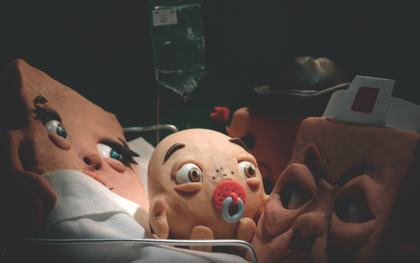
I Am Round
The teenage voice cast of Pickels in a Pickel – about a careless pig who almost ruins his friends’ day out – also answered keen questions from the floor, only faltering when asked to perform Pickels’ theme song.
An unspoken sense of occasion pervades the whole event, but it’s not all sweeties and delights. Ziluks told an amusing story about a vulnerable acorn being raised by his new forest friends but wasn’t afraid to expose the underling to danger.
And the last film of the programme, I Am Round (Jag Är Rund), broke a beautifully happy dream sequence to offer a blunt, joyless ending. Stunned by this unexpectedly downbeat finale, I looked to my seven-year-old to gauge her mood. She was surprised, and disappointed, but didn’t stop talking about it all the way home.
Nick Bradshaw, 19 October
I took my two-year-old to the family screening of Alain Gagnol and Jean-Loup Felicioli’s animated cat-burglar caper A Cat in Paris, but – felinophile though she may be – she waxed restless half an hour in and showed me the door. I’m still unenlightened as to whether the titular tiger-striped Dino and his nocturnal burglar pal Nico managed to save young Zoe from the dastardly clutches of international treasure-snatching kingpin Victor Costa and his gang of buffoons, or which of them Zoe’s mum – the widowed, work-stressed commissioner of police – decided to pursue. Nor do I know whether the turn-off was the rather sepulchral atmosphere in NFT2 (not to mention the headphone translation), or whether the film’s charms were too energetic for a two-year-old. Maybe all these things.
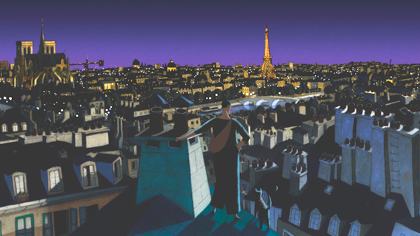
A Cat in Paris
Over in the International Animation Panorama programmes, growing pains and romance were typically the order of the day, though styles at least were diverse. Emma Burch’s Being Bradford Dillman concerned a lonely girl’s brief imaginary friendship with the phantom of the boy that her overly flippant mother claims she was born as; the scenario wasn’t given vastly original treatment, but I liked the (unseen) mother’s alky acidulousness, and the composited hand-coloured foregrounds and photographic backgrounds were handsomely done.
From the National Film & Television School, Corinne Ladeinde’s Ernesto made some sweet music with the vagaries of schoolyard individuality as a young boy’s teeth first fail to fall out like all the other kids’, then start expressing themselves in soul song.
From Portugal, José Miguel Ribeiro’s Dodu the Cardboard Boy was a wordless – and somewhat aimless – reverie about a young dreamer adrift on a sea of his feelings, while (from the Royal College of Art) Yoonah Nam’s Henrick attempted a more layered disquisition about an acquaintance of the narrator, with lots of verbal play and visual metamorphosis; I felt its elliptical philosophy rather ran through my fingers.
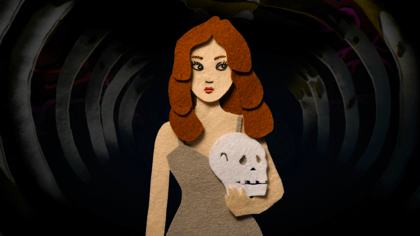
To Die By Your Side
Several of the grown-up stories – from Germany, Ralf Kukula’s The Man Who Still Believed in the Stork, a faux-naive urban fairytale about a handsome asexual; from the UK, Neil Boyle’s The Last Belle, a portrait of an abortive blind date with lashings of dramatic irony and virtuoso slapstick; from Argentina, Luminaris, Juan Pablo Zaramella’s expertly pixillated short fantasia about two workers in a light-bulb factory – showed off great style and vim while rehearsing fairly pat storylines.
It’s tempting to level the same criticism at Spike Jonze’s collaboration with Simon Cahn and designer Olympia Le-Tan, To Die By Your Side (Mourir Auprès de Toi), a romance in Paris’s Shakespeare and Co bookshop featuring felt cut-outs characters from the covers of Macbeth, Dracula and Moby Dick; but then again the film never claims the status of anything other than one of Jonze’s quick-fire viral sketches, and the felt animation has the hand-made pleasurableness of a Michel Gondry short. (You can watch it here.)
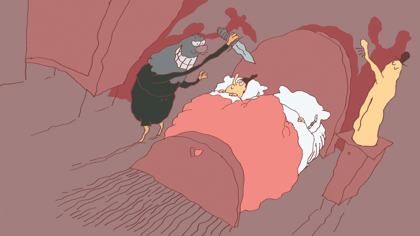
Oedipus
Also daffy fun is Dutch-Canadian master Paul Driessen’s jelly-straight Oedipus, in which the cuckolding milkman of the title takes therapy to rewind his life and try to understand women; besides the gattling-gun pace, Driessen wisely has Oedipus parse his thoughts in loopy Mexican-accented pigeon English.
At the more pensive, ‘refined’ end of the spectrum, Daniel Ojari’s Slow Derek and Koji Yamamura’s Muybridge’s Strings both wordlessly and elliptically reflect on time and change (and feature the old movies-as-trains metaphor). Slow Derek – about an office drudge swept away by the speed of the turning world – feels slighter, but its rich model work is very fetching.
Fluidly pencil-drawn and painted, Muybridge’s Strings re-rehearses the zoopraxographer’s experiments with motion photography and time capture as an analogy for a contemporary mother’s angst about her growing child. It’s beautiful, but if you know your Muybridge it feels a little obvious.
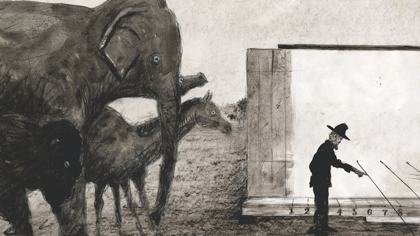
Muybridge’s Strings
There was also expert biography in veteran animator Barry Purves’s Tchaikovsky: An Elegy – a multimedia synthesis of puppet and model work, animated old photos and quotes from the composer’s diaries and music that teeters between poignant tribute and over-earnest digest (the flat-footed English voice-over doesn’t help its cause).
Dance, dress and negative space meanwhile are the inflecting elements of Fiona Geilinger’s trompe l’oeil minimalist Wallpaper, in which a woman variously reveals and conceals herself against a white backdrop using the shifting shapes of her dress, until she finally embraces the background as wallpaper.
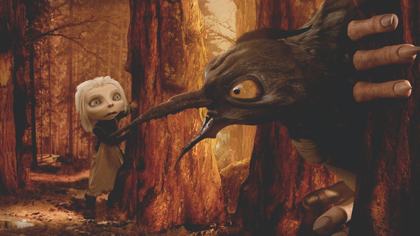
The Monster of Nix
All of which leaves just The Monster of Nix, a tumultuous, bewildering CG musical fantasy epic from Dutch artist / online graphic novelist Rosto featuring an elfin-faced lost urchin, multiple planes of reality, a self-reflexivity (stories are collected inside mercury-coloured ‘eggs’ by stick-like scarecrow figures), a crow with human hands for feet and the voices of both Tom Waits and Terry Gilliam galumphing away on the soundtrack.
A bit of a short-form blockbuster, the film had crowded out all exposition; there was certainly talent flying around the screen – you can see why Gilliam got involved – but no subtlety or respite. I found the handheld CG camerawork of some interest, but otherwise had a yen to show myself the door.
« Early ups and downs: ‘We Are the World’ movies and more
Chicken with Plums: over-plummed? »
See also
Quick cuts and slow change: Laura Allsop on the Arts Council funding cuts and experimental filmmaking in the UK (May 2011)
The Illusionist reviewed by Anton Bitel (September 2010)
Kawamoto Kihachiro, 1925-2010: Jasper Sharp remembers the puppet maker and stop-motion animator (September 2010)
Annecy’s animated crowd: Isabella Kaminski on the Annecy Animation Festival (August 2010)
Me and Joseph Brodsky: Andrey Khrzahanovsky talks to Nick Bradshaw about Room and a Half (May 2010)
